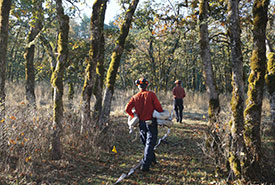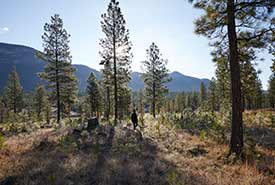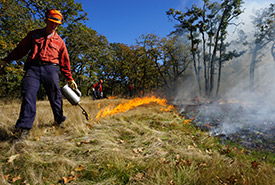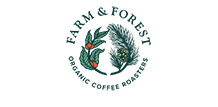Understanding and managing wildfire in British Columbia

BCWS firefighters at the Cowichan Garry Oak Preserve (Photo by Virginia Hudson)
Fire has shaped the world since time immemorial, forging and transforming human civilizations and natural landscapes alike. Many ecosystems in British Columbia rely on natural fires to regenerate. The intentional use of controlled burns to manage and enhance landscapes has been practiced by people for millennia. But fire can also be a frightening and destructive force, as we have witnessed during many recent summers in this province, and around the world.
It has never been more urgent to increase our understanding of and preparedness for wildfires on natural landscapes. As a conservation organization that works with nature to protect and enhance BC’s ecological diversity and resiliency, the Nature Conservancy of Canada (NCC) is learning to harness the beneficial aspects of fire on the landscape, while also increasing our preparedness to manage and minimize destructive wildfires.
Ecological role of wildfire
Many forests and grasslands in BC have evolved as “fire-maintained ecosystems.” This means that periodic low-intensity wildfires help keep the landscape from evolving into a different state by knocking back some of the shrubs and trees that will eventually turn grassland, say, into a dense forest. Many species of wildlife would lose the habitat they rely on if occasional forest fires didn’t clear out some growth and help create the standing dead trees that are home to cavity-nesting birds, small mammals and insects.

Open forest structure of Kootenay River Ranch (Photo by Colin Way)
Fire can also help a forest regenerate. Some trees, such as lodgepole pine, need the heat of a fire to open their tight cones and release the seeds of new growth. As sticks, needles and other organic debris on the forest floor are burned up, important nutrients are released back into the soil. Fires create openings in the forest canopy, which allow more sunlight to reach the forest floor and stimulate new growth. In the year after a fire, you can expect to find an explosion of mushrooms and, after that, an abundance of berries, in some ecosystems.
The post-fire forest is a boon for wildlife. Insects feed on the burned bark and dead wood. Woodpeckers, nighthawks and small mammals feed on those insects. Grazing animals feast on the new shoots and berries that flourish as the forest regenerates. Predators, in turn, are rewarded with increased prey populations.
But these benefits can be lost if a fire burns at too high an intensity for too long. These destructive mega-fires are becoming increasingly common as we face hotter, drier springs and summers combined with a buildup of forest litter from decades of fire suppression.
Managing the destructive potential of wildfire
We have seen an increase in large and destructive wildfires in BC in recent years. These high-intensity fires burn through forests, brush and grasslands and have a significant negative impact on ecosystems, communities and human health. Historical fire data shows that BC (along with Alberta and the Northwest Territories) has experienced increasingly frequent and destructive wildfires over the past 60 years. Scientists predict that climate change is already playing a role in intensifying wildfires, and that this trend will only continue.

Burning a restoration slash pile. (Photo by NCC)
NCC manages its land to restore and enhance natural ecosystem processes. This approach supports wildlife, ecological services (such as cleaning air and water) and can build fire resiliency by returning a landscape to a state that is less likely to encourage a wildfire to grow into a devastating, high-intensity one.
Functioning ecosystems are naturally more resilient to fire. NCC works to restore and enhance biodiversity and ecological systems on our land, which also encourages a natural resilience to catastrophic wildfire.
Restoration actions that help build fire resilience landscapes:
-
thinning ingrown/dense forest;
-
removing trees that are dying due to forest health issues, such as beetle kill or drought;
-
removing woody invasive species and encroaching shrubs; and
-
planting native species, especially less fire-prone deciduous species.
The potential of prescribed burns

BC Wildfire Service staff member participating in prescribed burn (Photo by NCC)
NCC also supports the use of prescribed burns on our and our partners’ lands, where ecologically and culturally appropriate. Prescribed burns are the intentional use of controlled fire to manage and enhance the natural processes of a specific land area. This technique has been used by people for thousands of years to manage lands for resources, safety and forest health.
Conservation agencies, governments and other land managers are increasingly looking to the use of careful, intentional burns to help manage natural lands in BC. (See the BC Wildfire Service (BCWS) website for information on prescribed burning.)
With the help of several partners, including BCWS, NCC has conducted successful, small controlled burns on Garry oak meadow habitat in the Cowichan Valley. We are working toward re-establishing careful burns on our lands in other fire-maintained landscapes, such as in the Rocky Mountain Trench and on Darkwoods.
What we do when the fire risk soars
NCC takes a cautious approach to fire risk on our lands. The safety of our staff, contractors and the community is our top priority. We maintain proactive communications with users on our lands about fire risk and the precautions we expect everyone to take.
Our field staff carry basic fire response equipment in their vehicles for emergencies and follow provincial standards for wildfire prevention when engaging in high fire-risk activities. We will proactively close conservation areas when the fire risk is too high to reduce the risk of a fire being sparked accidentally by human activity. Limiting activity on NCC’s lands during high fire-risk situations is both a public safety precaution and ensures the BCWS can operate in an area without interference.
An essential part of our fire risk management involves working in partnership with BCWS to conduct a seasonal fire analysis. This provincial agency is responsible for wildfire control and protection, and like everyone else in BC, NCC relies on the expertise, skill and resources of BCWS to address wildfires on our lands. If a fire does ignite, BCWS leads the monitoring and control of the fire, with our support.




